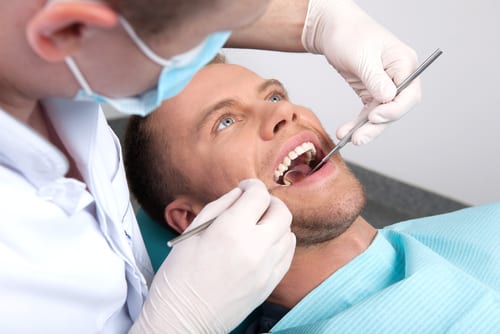Posted August 21, 2019 in Cavities, News, Oral Cancer, Oral Hygiene, Periodontal Services
While it may be uncomfortable to push yourself to every dentist appointment—especially if you know you have not been eating properly to maintain the health of your teeth and gums—making sure you are attending regular appointments could do more than let your dentist catch a cavity or two.
American tennis star Nicole Gibbs was recently diagnosed with salivary gland cancer after her dentist noticed an irregular bump on the roof of her mouth during a routine appointment. Luckily, the growth was caught early enough that surgery would remove the cancer entirely, but if Nicole had skipped her appointment (or a few appointments, like we all sometimes do), it is possible that the outcome could have been much worse.

What Are the Different Types of Mouth Cancer?
There are six different places where cancer can develop in the mouth:
- Gums: Cancer found in this area is easily mistaken for gingivitis. But, if caught early, it is highly treatable. The most common signs are discolored (white, red, or darkened) patches in the mouth or thick and bleeding gums.
- Hard Palate: Although it is exceedingly rare to find cancer in this part of the mouth, it is still possible, as proven by Nicole Gibbs’ diagnosis. The most common sign is an ulcer or growth on the roof of the mouth.
- Inner Cheek: Using tobacco products and regularly drinking too much are the easiest ways to develop cancer in this area. Inner cheek cancer can be identified through discolored (white, red, or darkened) patches in the mouth, lumps, mouth or ear pain, loose teeth, or jaw swelling.
- Lips: Tobacco and alcohol products can contribute to the development of this cancer. Here are some of the most common symptoms: sores, lumps, bleeding, pain, or numbness on the lips. People who are male, have light-colored skin, have been infected with human papillomavirus (HPV), or are over the age of 40 or at higher risk of developing lip cancer.
- Tongue: Oral cancer can develop in the oral tongue (the part that you use to taste) or the base of the tongue. The symptoms of this type of cancer are similar to the inner cheek. Typically, this cancer is linked to tobacco or alcohol consumption.
- Floor of the Mouth: According to the Memorial Sloan Kettering Cancer Center, dentists are usually the first to notice this type of cancer during a routine exam. If caught early enough, it is possible to preserve both the appearance and function of your mouth by preventing cancer from spreading.
This means that, unless you are making regular visits to a dentist who makes his way through each of these areas to check for oral cancer, it is highly unlikely that you will be able to spot a growth quickly enough to avoid the worst outcome, even if you are aware of all the symptoms or are as healthy as an award-winning tennis player.

What Other Conditions Can Dentists Catch?
While they are likely to catch different signs of cancer during regular check-ups, dentists can also diagnose and treat a variety of other conditions like tooth decay, periodontal (gum) disease, cavities, leukoplakia, bacterial infections, and abscesses.
If you have experienced any of these symptoms or conditions, or if you would like to undergo a check-up to ensure a healthy mouth, please give Gentle Care Dentistry a call at 575-524-3722 or visit our online consultation scheduling page.